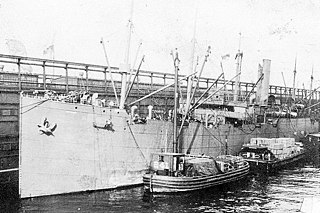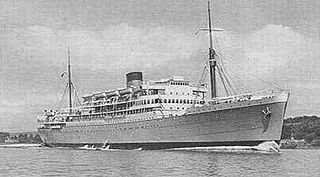
SS Akaroa was a UK steam ocean liner and refrigerated cargo ship. She was launched in 1914 in Ireland as Euripides for Aberdeen Line. When new, she was the largest ship in the Aberdeen Line fleet.

Empire Bittern was a steamship, built as a livestock-carrying cargo ship in 1902 at Belfast, Ireland as Iowa for the White Diamond Steamship Company Ltd of Liverpool. The ship was sold to the Hamburg Amerika Linie and renamed Bohemia in 1913.
SS Tregenna was a cargo steamship that was launched in England in 1919 and sunk by a U-boat in the Battle of the Atlantic in 1940 with the loss of 33 of her 37 crew. She was laid down as War Bulldog, but the Hain Steam Ship Co bought her before she was completed and renamed her Tregenna.

SS Hilary was a British steam passenger liner that was built in 1931 and scrapped in 1959. She spent much of her career on a scheduled service between Liverpool in England and Manaus in Brazil.

USS Howick Hall (ID-1303) was a cargo steamship that was built in Scotland in 1910 and served in the merchant fleets of the United Kingdom, United States, Italy and Panama. She served in the United States Army in 1917–18 and then the United States Navy in 1918–19. The United States Maritime Commission bought her in 1941, and a German air attack sank her in 1942.
SS Gairsoppa was a British cargo steamship that was built in 1919 and sunk in the Battle of the Atlantic in 1941. 85 of her complement were killed, and only one person survived. When she was sunk, her cargo included 7 million ounces of silver bullion. In 2012 and 2013 a US company recovered part of the bullion, and in 2014 the Royal Mint struck 20,000 silver coins from it.
MV El Argentino was a refrigerated cargo motor ship that was built in Scotland in 1920 and sunk by a German aircraft in the Atlantic Ocean in 1943.
SS Canonesa was a refrigerated cargo steamship that was built in Ireland in 1920 and sunk by a u-boat in the Atlantic Ocean in 1940.
SS Umona was a British cargo liner. She was built at Sunderland on the River Wear in 1910, survived the First World War and was sunk by enemy action off Sierra Leone, West Africa in 1941.

SS City of Bradford was a British passenger and cargo steamship that was built in Yorkshire in 1903, renamed Donau in 1916, reverted to City of Bradford in 1919 and became Hanne in 1936.

SS Cathay was a P&O passenger steamship that was built in Scotland in 1925 and sunk in the Mediterranean Sea in 1942. In the Second World War she was first an armed merchant cruiser and then a troop ship. In 1942 she took part in Operation Torch, and was sunk in a German air raid off Bougie, Algeria.
SS Benlomond was a British cargo steamship that was built in 1922 as Cynthiana, changed owners and names a number of times, and was sunk by a U-boat in 1942, with the loss of all but one of her 53 ship's company. The sole survivor, Poon Lim, drifted on a raft for 133 days before being rescued.

HMS Dunvegan Castle was a UK ocean liner that was converted into an armed merchant cruiser (AMC) in the Second World War. Harland and Wolff built her and her sister ship Dunnottar Castle in Belfast in 1936.
SS Tregarthen was a cargo steamship that was built in Scotland for the Hain Steam Ship Co in 1936. She was sunk with all hands by a U-boat in 1941 in the Battle of the Atlantic.
SS Hartlebury was a cargo steamship that was launched in Scotland in 1934 for J&C Harrison Ltd. A U-boat sank her in the Barents Sea in 1942 when Hartlebury was a member of the Arctic convoy Convoy PQ 17.
HMS Crispin was a British cargo steamship that was launched in England in 1934 and operated by Alfred Booth and Company between Liverpool and the east coast of South America. In 1940 the British Admiralty requisitioned her and had her converted into an ocean boarding vessel. In 1941 a U-boat sank her in the Battle of the Atlantic, killing 20 of her crew.
SS Pennington Court was a British cargo steamship. She was launched in 1924 as Rochdale and renamed Pennington Court in 1927. In the Second World War she carried iron ore, grain and other supplies to Britain. She was sunk with all hands in the Battle of the Atlantic in 1942.
SS Verdala was a cargo and passenger steamship that was built in Scotland in 1913. Several times she changed owners and was renamed: as Mongolian Prince in 1917, Istok in 1928 and finally Maycrest in 1940.
SS St. Elwyn was a cargo steamship that was built in England in 1938 and owned by the South American Saint Line. A German U-boat sank her in the Atlantic Ocean in 1940, with the loss of 24 of her crew.
SS Manchester City was a British cargo steamship that was built in Glasgow in 1937 and scrapped in Faslane in 1964. The Royal Navy requisitioned her in the Second World War.






